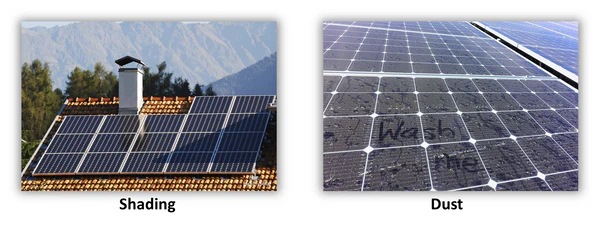Solar energy is a smart and sustainable way to reduce your electricity bills. But what if your solar panels are not producing enough power? Many homeowners in India face low solar power output, especially after a few years of installation. In this guide, we’ll help you understand the causes and how to fix them—step by step.
Why Your Solar Panels Might Be Underperforming

A properly installed solar system should generate power close to its rated capacity. For example, a 5 kW system should produce 20 to 25 units per day, depending on location and weather. But sometimes, output drops much lower. This could be due to dirt, shade, heat, wiring issues, inverter problems, or equipment aging.
Knowing how to identify these issues helps you fix them quickly and protect your investment.
Top Causes of Low Solar Output in India
1. Dust and Pollution on Solar Panels
India’s climate brings high dust levels, especially in urban areas and during dry seasons. Dirt, bird droppings, and pollution block sunlight, reducing energy generation.
Fix: Clean your panels every 2–4 months. Use plain water and a soft cloth. Avoid cleaning during hot afternoons to prevent cracking the glass due to thermal shock.
Solar panel cleaning in India, solar power loss due to dust.
2. Shading from Trees or Buildings
Even a small shadow can cause major energy loss in a solar panel string. This is especially true for string inverter systems common in Indian homes.
Fix: Trim nearby trees regularly. Watch for new constructions that may block sunlight, especially during winter when the sun is lower in the sky.
Shade impact on solar panels, solar output loss due to shadow.
3. High Temperatures
Heat affects panel efficiency. In Indian summers, panel temperatures can rise above 60°C, causing a drop in performance.
Fix: Use panels with better temperature coefficients. Ensure there’s enough airflow beneath your panels.
Solar panel efficiency in hot climates, Indian weather solar output.
Also Read The Ultimate Solar Panel Maintenance Guide for Indian Homes
4. Loose Connections or Wiring Faults
Wiring issues, corrosion, or poorly installed connectors can reduce or cut off power from your solar panels.
Fix: Check cables, MC4 connectors, junction boxes, and earthing every 6–12 months. Look for signs of burning or exposed wires.
Solar wiring issues, solar system safety check India.
5. Inverter Malfunction
Your inverter converts DC from panels to usable AC power. If it’s faulty or outdated, your system won’t perform as expected.
Fix: Monitor the inverter screen or app for error messages. If your inverter light is red or orange, call a technician immediately.
Solar inverter problem, low DC voltage from solar panels.
6. Panel Degradation and Defects
All solar panels degrade over time. Cheap or low-quality panels may degrade faster. Cracks, discoloration, or water damage also cause reduced efficiency.
Fix: Check for visible signs like micro-cracks, bubbles, or snail trails. Get a professional inspection done every 2–3 years.
Solar panel degradation India, cracked solar panel repair.

How to Troubleshoot Low Solar Output: Step-by-Step Guide
Step 1: Visually Inspect Your Solar System
Walk around your installation. Look for visible damage, shade, or debris on the panels.
Step 2: Check Power Generation Data
Most systems have apps or displays showing daily and monthly output. Compare with past data and weather trends. If there’s a drop without a clear reason, you need to investigate.
Step 3: Clean Your Panels
Clean with water and a soft brush. Avoid detergent. Clean in early morning or late evening. In highly dusty regions, clean monthly.
Step 4: Monitor the Inverter
Ensure the inverter is on and the lights are green. Red or blinking lights indicate a fault.
Step 5: Call a Technician
If performance remains low after cleaning and visual checks, hire a certified solar expert. They can measure voltage, current, and insulation to find the exact problem.
Common FAQs on Solar Power Loss in India
Q1: How much does dust affect solar performance?
Dust can reduce solar power by 10–30% in dry or polluted areas. Regular cleaning is essential.
Q2: What if one panel is shaded?
One shaded panel in a string can reduce the output of the entire string. That’s why avoiding shadows is crucial.
Q3: Does temperature affect solar panel output?
Yes. Indian summers can cause panels to overheat, lowering efficiency. Choose high-quality panels with better heat resistance.
Q4: Can my inverter go bad over time?
Yes. Inverters usually last 8–12 years. Monitor them often and replace if they show signs of failure.
Q5: How often should I get my system inspected?
An annual inspection by a solar expert can prevent bigger issues and keep your system performing well.
Summary Table: Fixing Low Solar Output in Indian Homes
| Problem | Impact on Power | Suggested Fix |
|---|---|---|
| Dust and dirt | 10–30% output loss | Clean every 2–4 months |
| Shadowing from trees/buildings | Full string loss | Trim trees, adjust panel position |
| Overheating | 5–25% output loss | Allow airflow, choose better panels |
| Loose wires or poor connections | Sudden drop to zero | Inspect and fix wiring |
| Inverter not working properly | Reduced AC output | Monitor, repair or replace inverter |
| Panel degradation or damage | Permanent efficiency loss | Replace old or damaged panels |
Final Thoughts: Protect Your Solar Investment
Solar systems are a long-term investment. But to get the best returns, regular maintenance is essential. In India, dust, heat, and humidity create extra challenges. So keep an eye on your system’s performance. Act quickly when output drops.
If your solar panels are producing less power, don’t panic. Use the steps above to troubleshoot. Often, it’s something simple. But if not, call a solar expert to check wiring, inverter, and panel health.
A small fix can lead to bigger savings—and more clean energy for your home.










